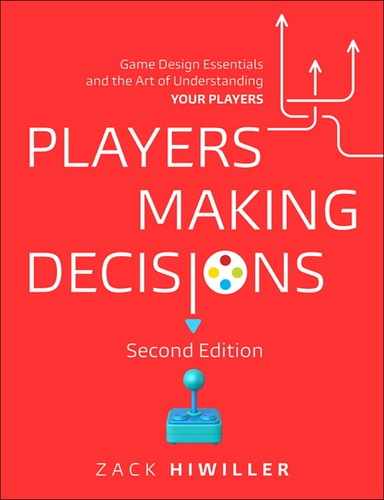Part 2: Prototypes and Playtesting
A mirror will not show you yourself, if you do not wish to see.
—ROGER ZELAZNY, LORD OF LIGHT
After you have a vague hand-wavy understanding of what you plan on building, the next step is to create a prototype. A prototype is a quickly assembled sketch of a game. “Quickly assembled,” however, is relative. For a game that will be made over the course of years, a prototype may take months to build. For a small card game, a prototype can be assembled in minutes. Prototypes are the single most useful tool for game designers for many reasons:
• Prototypes force the designer to make decisions about non-obvious edge cases.
• Prototypes focus on the core idea without the designer having to spend time on expensive polish elements. Often, digital prototypes prove the core of a game without heavy time investments of art, animation, and code polish.
• Prototypes can be tested by impartial players using playtesting techniques. Playtests allow players to provide feedback without wearing the rose-colored glasses of the designer; feedback includes issues of balance, cognitive load (see Chapter 24), and edge cases.
• It is comparatively easier to change items in a prototype than it is when you are making something for a shippable version. This is functional because it’s quicker to change scribbled note cards than it is to redesign a finished card in Adobe Illustrator, and it’s psychological because it’s easier to give up on something when not a lot of cost or time has been invested.
There is no standard method for creating a prototype. Digital prototypes use whichever languages and libraries are most familiar to those making the prototype. Paper prototypes are often created with whatever materials are available. The most flexible materials for paper prototyping are note cards and dice. Simply leverage the materials that support the basic rules you have envisioned. Whenever a question comes up that the rules and materials do not support, amend your rules and materials so that the game can continue.
If you are prototyping an analog game, it’s often okay to prototype the entire experience at once. If the game is a role-playing or storytelling game, it is best to limit your prototype to one scenario.
If the game is digital, return to the question of what it is that the player does. Your prototype can focus on just that interaction. If your game is a platformer, then movement and jumping should be the focus of the prototype. It can later expand to include the mechanics that make the idea unique. If the game is a first-person shooter, then the prototype should focus on movement and shooting.
When building prototypes, failure is an option. The reason prototypes are built as quickly as possible at first is because failure is expected. The prototype shows the designer where the original ideas are unfun or suboptimal. The designer can then refine or change those ideas easily because of the prototype’s malleability. Be prepared to throw away ideas you like.
Once you have a prototype, it is necessary to begin playtesting as soon as possible. Methods for doing so are explained in later sections. Playtesting is the process of evaluating a prototype against a set of criteria. Playtesting is most often accomplished by getting new players to try your game.
By playtesting as soon as possible, you’ll be able to determine if you are meeting your design goals as defined in your problem statement. The later in the project that playtesting happens, the more difficult it is to change what you have implemented, and you may have to settle for not meeting parts of your design goals.
Playtesting takes a lot of time. When playtesting is over, you may need to start making the game over again using everything you learned in the prototyping and playtesting process.
